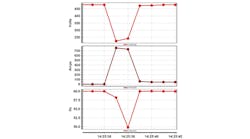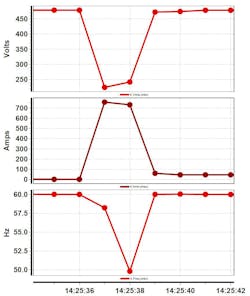A facility recently transferred from their temporary power feed to a new permanent feed. The facility’s hydraulic pump ran smoothly when connected to the temporary feed, along with other construction equipment. However, when the pump was connected to the new switchgear, it would no longer start. It also tripped multiple circuit breakers upstream from the equipment. The facility manager decided to rent a generator and connect directly to the pump, bypassing the new feed. The pump is vital to the facility’s operations and could not be down for long.
In troubleshooting this issue, we asked ourselves several questions. What would cause a hydraulic pump to run when connected to a generator but not on the main feed? What changed between the temporary and permanent feed? Was it related to the size of the transformer, the wire size feeding the pump, the load demand, or the protection settings? In this case, it was all of the above.
Before making any assumptions, we did what most investigators would do when first starting out — gather information. The initial thought from the facility lead was that the newly installed transformer on the permanent feed was undersized and the voltage was sagging significantly during startup, which caused the pump to pull an excessive amount of current. From the data we collected, this was not the case. We connected multiple power quality monitors at different points on the new feed and then attempted to start the pump, which failed. We compared this data with the same test performed while the pump was connected directly to the generator.
The Figure shows the voltage, current, and frequency profiles when the pump is starting when connected to the generator.
As the pump is energized, the current demand sagged the voltage and the generator’s speed (represented by the frequency). The generator rode through the pump’s startup demand and recovered without tripping its internal circuit breaker. This is not the case when the pump is connected to the permanent feed. The voltage and frequency did not sag, and the current demand was much higher when measured at the switchgear. What we came to discover after comparing the data sets, was that the switchgear’s protection settings on the permanent feed were too sensitive and did not accomodate for the pump’s inrush current. Upon further investigation, it was determined that the handoffs between the different personnel did not include reviewing the default protection settings.




